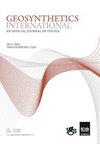GMX/GDC强度损失机制
IF 3.3
2区 工程技术
Q2 ENGINEERING, GEOLOGICAL
引用次数: 0
摘要
本文深入探讨了纹理土工膜(GMX)和非织造土工布(NGT)界面峰后强度损失的原因。NGT可以是土工合成排水复合材料(GDC)的一部分,也可以是独立的NGT。该研究使用了环剪试验,在达到残余强度条件后更换两种界面材料中的一种,并重新开始试验以测量界面强度的变化。界面强度从峰值到大位移(LD)强度的损失主要来自三种机制:(1)土工膜磨损,(2)NGT中纤维的断裂和梳理,以及减少GMX微凸体与NGT纤维之间的钩环效应。从LD强度到残余值的界面强度损失来源主要来自于环剪试验中NGT纤维平行于剪切方向的断裂和连续梳理。剪切前后GMX和NGT的扫描电子显微镜照片证实了GMX凹凸的磨损和光滑以及NGT纤维在剪切方向上的梳理。本文章由计算机程序翻译,如有差异,请以英文原文为准。
GMX/GDC strength loss mechanisms
This paper provides insight into the causes of post-peak strength loss for textured geomembrane (GMX) and nonwoven geotextile (NGT) interfaces. The NGT can be part of a geosynthetic drainage composite (GDC) or a stand-alone NGT. The study used ring shear tests where one of the two interface materials was replaced after reaching a residual strength condition and restarting the test to measure the change in interface strength. The interface strength loss from peak to large displacement (LD) strength primarily comes from three mechanisms: (1) geomembrane wear, (2) breakage and combing of fibers in the NGT, and reduction of the hook and loop effect between GMX asperities and fibers of the NGT. The source of interface strength loss from LD strength to the residual value mainly comes from breakage and continuous combing of NGT fibers parallel to the direction of shear in ring shear tests. Scanning electron microscope photographs of the GMX and NGT before and after shearing confirm wear and smoothing of GMX asperities and the combing of NGT fibers in the direction of shear.
求助全文
通过发布文献求助,成功后即可免费获取论文全文。
去求助
来源期刊

Geosynthetics International
ENGINEERING, GEOLOGICAL-GEOSCIENCES, MULTIDISCIPLINARY
CiteScore
6.90
自引率
20.00%
发文量
91
审稿时长
>12 weeks
期刊介绍:
An online only, rapid publication journal, Geosynthetics International – an official journal of the International Geosynthetics Society (IGS) – publishes the best information on current geosynthetics technology in research, design innovation, new materials and construction practice.
Topics covered
The whole of geosynthetic materials (including natural fibre products) such as research, behaviour, performance analysis, testing, design, construction methods, case histories and field experience. Geosynthetics International is received by all members of the IGS as part of their membership, and is published in e-only format six times a year.
 求助内容:
求助内容: 应助结果提醒方式:
应助结果提醒方式:


